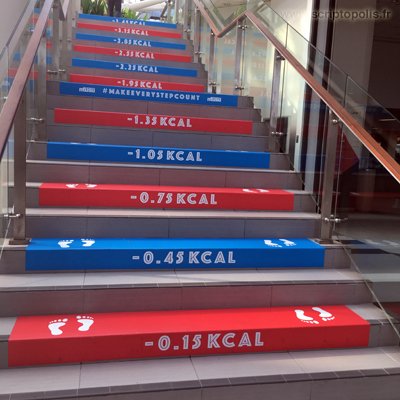Graduation

Singapore, february 2017.
On your daily journeys, you regularly encounter stairs. In a building, a shopping mall, the subway corridors, a historic building, or even an university campus… Sometimes abrupt and high, sometimes wide and spacious, the steps naturally follow one another to the top. Sometimes flanked by self-adhesive advertising inscriptions, they can sneak you into other spaces in order to arouse an emotion, a desire. But generally speaking, you don’t pay much attention to them: they are only mundane elements of the route that naturally leads you to your future destination.
On the other hand, in this technological university where, as in many other organizations, performance is king, the prioritization of entities is key and the production of numerical indicators is its main focus. In these conditions, climbing stairs means climbing ladders. The ascension is obviously not natural: the transition from one step to the next requires your physical commitment, but also that your attention is focused on the progression itself. Transparency obliges, you can appreciate the value of each of your progresses, displayed directly on the steps. Like a graduated ladder, the staircase presents itself as a performance space whose energy effects, calculated in “Kcal”, are immediately perceptible.
Thus, you can plan ahead in full knowledge – even if you forget your initial destination! What about the Kcal if you walk down? Is the gain the same if you go up by the right, at the opposite of the feet drawn on the left? What if you’re leaping on both feet? In any case, an identical lesson emerges. The longer the road, the more steps there are. But as the central inscription indicates, it is important to “make every step count”. In other words, any effort, however small it may be, is immediately rewarded!






